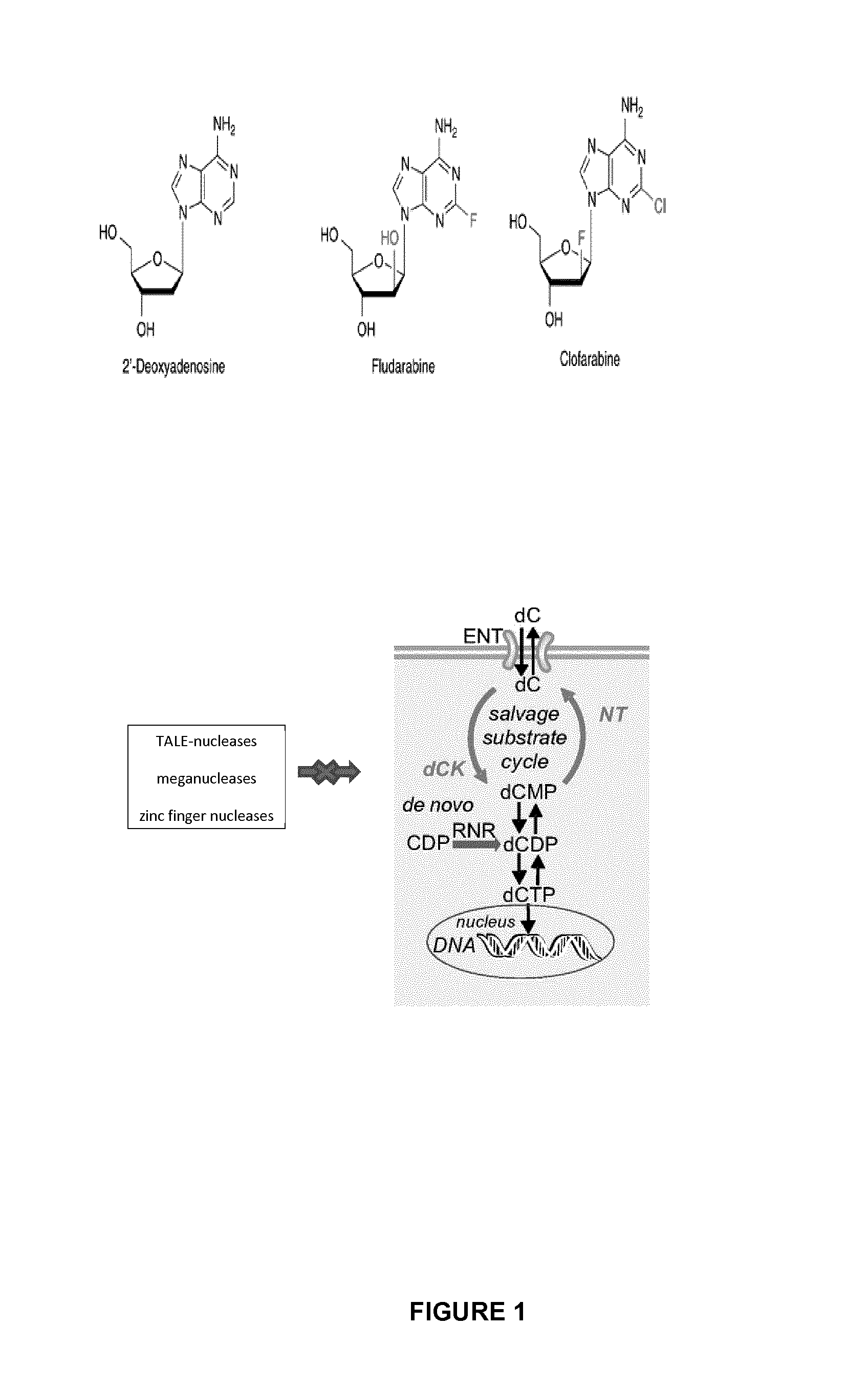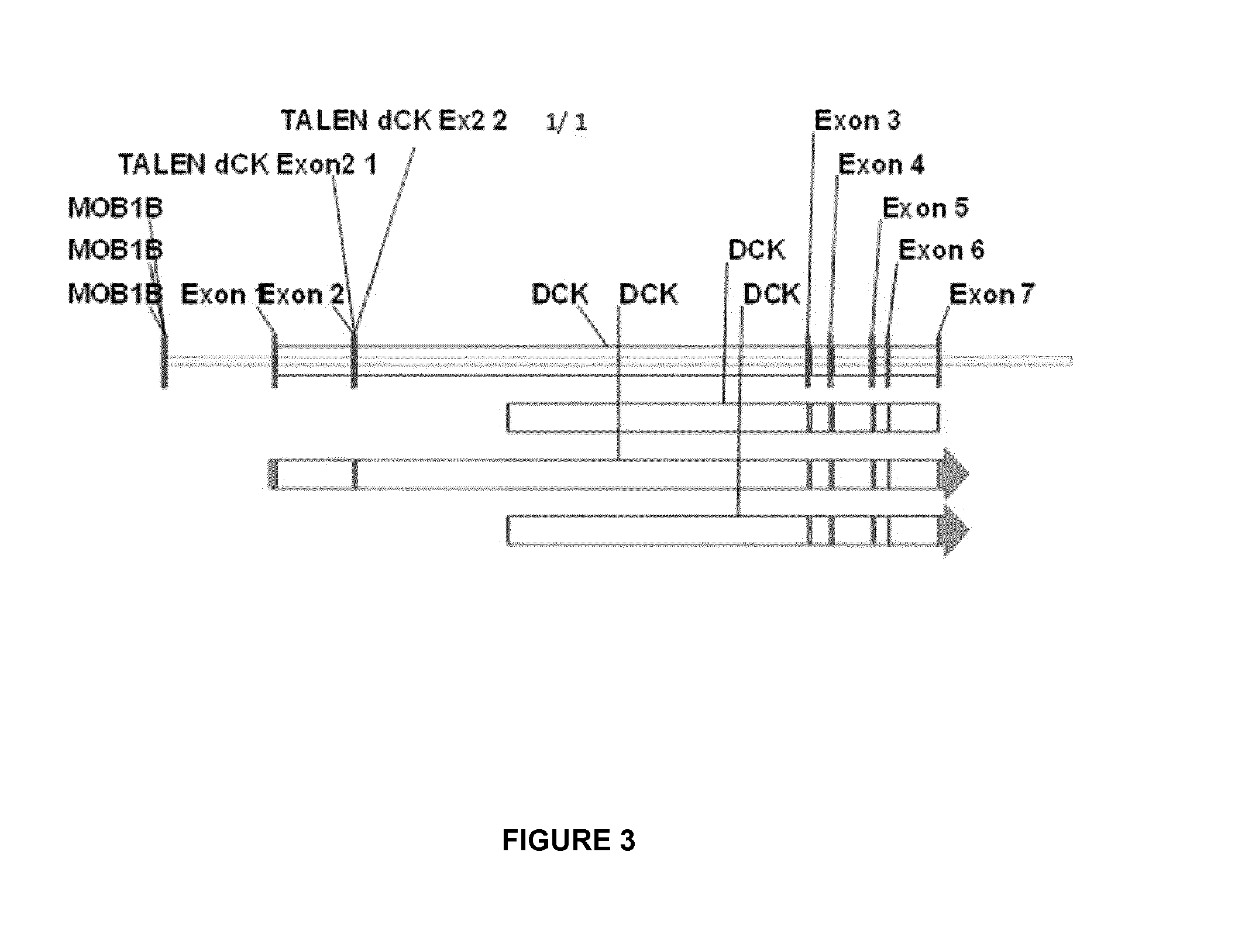Method of engineering chemotherapy drug resistant t-cells for immunotherapy
a technology of immunotherapy and chemotherapy drug resistance, applied in the field of immunotherapy, can solve the problems of degrading immune function, low number of patient lymphocytes, and poor function of patient lymphocytes, and achieve the effects of serious tissue damage and death, and reduced immunogenicity
- Summary
- Abstract
- Description
- Claims
- Application Information
AI Technical Summary
Benefits of technology
Problems solved by technology
Method used
Image
Examples
example 1
Generation and Characterization of Clofarafine Resistant T Cells
TALE-Nuclease-Mediated Inactivation of dCK
[0220]To inactivate dCK, two pairs of dCK TALE-nucleases were designed, assembled and validated by sequencing; subsequent work was performed only with the pair named TALE-nuclease dCK2 and having SEQ ID NO:63 and SEQ ID NO:64. The details regarding the dCK gene overall architecture (exons and introns) and the sequences of TALE-nuclease target sites located in the exon 2 are indicated in FIG. 3.
[0221]The dCK target sequence for the TALE-nuclease dCK2 pair corresponds to SEQ ID No 62.
[0222]Once validated, mRNAs encoding the two TALE-nucleases were produced, polyadenylated and used to electroporate T cells using pulse agile technology (5 or 10 μg of TALE-nuclease mRNA left and right were used) such as described in the WO 2013 / 176915. A cold temperature shock was performed by incubating T cells at 30° C. immediately after electroporation and for 24 hours. A reactivation (12.5 μl bea...
example 2
Generation and Characterization of Clofarabine Resistant Allogeneic T Cells
[0233]To develop and manufacture clofarabine resistant allogeneic CAR T cells, dCK and TRAC genes are inactivated simultaneously. After having demonstrated in Example 1 that dCK inactivation was successful, TRAC / dCK double KO T cells were generated and characterized. Two workflows presented in FIG. 9 were followed in parallel. One of them corresponds to a period of 5 days incubation of cells in the presence of clofarabine.
Genotypic Characterization
[0234]To first assess the efficiency as well as the kinetic of TRAC and / or dCK gene inactivations, transfected cells were grown for 6 days and collected at D1, D3 and D6 to perform T7 assays at the dCK and TRAC loci. To achieve that, 2 pairs primers having respectively SEQ ID No 68 and No 69; and SEQ ID No 70 and No 71 were used in the T7 assays for the dCK and TRAC loci.
[0235]The protocol used in the one described in Reyon, D., Tsai, S. Q., Khayter, C., Foden, J. A...
example 3
Generation of Clofarabine-Resistant Daudi Cells
[0250]The objective is to prepare drug resistant CD19+ / Luc+ Daudi target cells to assess the cytotoxicity of clofarabine resistant allogeneic CAR T cells.
Genotypic Characterization of dCK KO Daudi Cells
[0251]dCK TALE-nuclease mRNA were prepared and Daudi cells were electroporated by dCK TALE-nuclease mRNA according to the protocols described in the WO2013 / 176915.
[0252]An endo T7 assay has been performed to assess dCK KO efficiency such as in Example 1. The analysis was performed 2 days post transfection. The primers have SEQ ID No 68 and No 69.
[0253]The results presented in FIG. 18 show a high inactivation of dCK gene.
Phenotypic Characterization of dCK KO Daudi Cells
[0254]Daudi cells were cultured in media having different concentrations of clofarabine (0; 0.1; 0.25; 0.5 and 1 μM) for several days and counted at each passage.
[0255]The results presented in FIG. 19 show that dCK KO Daudi cells were able to grow in the presence of up to 1 ...
PUM
| Property | Measurement | Unit |
|---|---|---|
| temperature | aaaaa | aaaaa |
| temperature | aaaaa | aaaaa |
| frequency | aaaaa | aaaaa |
Abstract
Description
Claims
Application Information
 Login to View More
Login to View More - R&D
- Intellectual Property
- Life Sciences
- Materials
- Tech Scout
- Unparalleled Data Quality
- Higher Quality Content
- 60% Fewer Hallucinations
Browse by: Latest US Patents, China's latest patents, Technical Efficacy Thesaurus, Application Domain, Technology Topic, Popular Technical Reports.
© 2025 PatSnap. All rights reserved.Legal|Privacy policy|Modern Slavery Act Transparency Statement|Sitemap|About US| Contact US: help@patsnap.com



